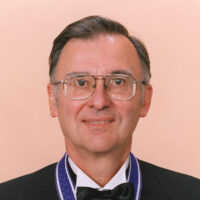
1997 Kyoto Prize Laureates
Electronics
/ Electronics Engineer
1937 -
Chief Technologist, FTI Teklicon, Inc.
A Few Thoughts on Computer Technology for the 21st Century
1997
11 /11 Tue
Place:Kyoto International Conference Center
The Birth of Microprocessor and Future Possibility
1997
11 /12 Wed
10:00 - 17:30
Place:Kyoto International Conference Center
Together, four engineers (Dr. Faggin, Dr. Hoff, Mr. Mazor and Dr. Shima) developed the world’s first microprocessor, the 4004. The four pioneers demonstrated that by integrating a few semiconductor chips, a microcomputer could be created which could perform a wide variety of functions. This paved the way for the development of all microprocessor-controlled industrial equipment and consumer electronics, contributing immeasurably to the creation of new industries, and to the progress of modern society.
A group of four engineers, Dr. Federico Faggin, Dr. Marcian Edward Hoff, Jr., Mr. Stanley Mazor, and Dr. Masatoshi Shima, co-developed in 1971 the world’s first general-purpose microprocessor, the 4004, which had a great impact on modern society, bringing about drastic changes in industrial and social structures worldwide.
The 4004 had 2,300 transistors mounted on a single silicon chip, measuring 3mm*4mm. Yet the 4004 could perform functions equivalent to an early computer’s central processing unit (CPU), which was as large as a room.
By combining the 4004 microprocessor with memories to store data and instructions, and I/O registers, a totally new system, the microcomputer, was developed. By changing configurations and programs, microcomputers can comply, at high efficiency, with user demands in a great variety of applications; for instance they can process numeric and text characters and graphics, and control various equipment and systems. Just as the invention of transistors and IC’s radically innovated electronic technologies, the development of the 4004 opened the door to a new age of programmable electronic components, and triggered further technological development. As a result, system construction technologies began to employ organic utilization of hardware and software, which in turn triggered the so-called “Second Industrial Revolution.” A quarter of a century has passed since the debut of the 4004, during which time data width increased from 4 bits to 8 bits, then to 16 bits, 32 bits, and most recently to 64 bits, along with extraordinary improvements in a machine’s computing and processing power. This amazing progress is attributable to the design concept of the first microprocessor, the 4004.
Today, microprocessors are incorporated in various tools and appliances used in our daily lives, including personal computers, consumer electronics products, automobiles, and telecommunication and medical equipment. In addition, microprocessors are widely employed in industrial machinery, especially machine tools. Of all devices invented by humans, nothing has had greater impact in such a short period of time than the microprocessor. The progress of electronics we now enjoy was triggered by the development of the 4004; electronic technology would not have developed as it did, were it not for the achievements of the four engineers: two Americans, one Italian, and one Japanese. For these reasons, The Inamori Foundation is pleased to bestow upon Dr. Federico Faggin, Dr. Marcian Edward Hoff, Jr., Mr. Stanley Mazor, and Dr. Masatoshi Shima the 1997 Kyoto Prizes in Advanced Technology.
Profile is at the time of the award.